Strad 3D project Contributors
- Sam Zygmuntowicz
- George Bissinger
- François Denis
- John Waddle
- Steven Alexander Sirr
- John Topham
- Yuri Namkung
- Joseph Curtin
- Martin Schleske
- Eugene Schenkman
- Da-Hong Seetoo
- Jeff Loen
- George Stoppani
- Tucker Densley
- Aaron Boyd
- Christopher Reuning
- Alvin Thomas King
- Fan-Tao Chia
- The Testing Team
- Polytec Inc
- Harry Bolick
- Additional Contributors
Samuel Zygmuntowicz Strad3D Creative director and producer
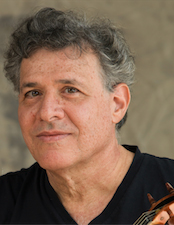 www.strad3D.org
www.strad3D.org
SZviolins@yahoo.com
Samuel Zygmuntowicz, born 1956 in Philadelphia, was already a prize-winning sculptor before beginning his instrument-making studies at age 13. He studied making and restoration with Peter Prier, Carl Becker and Rene Morel. His work has won high honors in international competitions, including double gold medals for violin tone and workmanship.
Since 1985 he has worked independently in Brooklyn, New York, making new instruments by advance commission, and working with performers such as Cho-Liang Lin, Joshua Bell, Maxim Vengerov, Yo-Yo Ma, Leila Josefowicz, and the Emerson String Quartet.
His work is documented in THE VIOLIN MAKER, a book that follows the complete process of building a new violin for Eugene Drucker.
In addition to his extensive studies of traditional violinmaking, often featured in THE STRAD magazine, he has worked closely with acoustic researchers and is often on staff at both the Violinmaking and Violin Acoustics Workshops at Oberlin College. He was involved with the first 3d laser vibration studies of Stradivari and Guarneri violins, under the direction of physicist George Bissinger.
He has presented his findings throughout the USA and internationaly, including the Chamber Music Society Of Lincoln Center, the Juilliard School, Friends of the St. Paul Chamber Orchestra, Music@Menlo and La Jolla Chamber Music festivals, the St. Lawrence String Qt. Chamber Music Program at Stanford, plus conferences including the American Society of Acoustics, Arts and Science at CUNY, the E.G. Conference, the Musical Instrument Museum in Pheonix AZ, and MOMATH in NYC, and in Italy, Sweden, England, Belgium, Spain, Australia, and Canada, including the Banff International String Quartet Competition.
Sam lives in Brooklyn NY, and plays fiddle with a variety of performing folk music groups. His CD recordings include JUMP WHEN THE TRUMPETS BLOW
George Bissinger Strad3D Acoustic Research Director
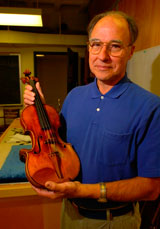 Dr. George Bissinger got into violin acoustics in 1969 following a chance meeting with Carleen Hutchins while a post-doctoral fellow at University of North Carolina-Chapel Hill where she was giving a colloquium. A second postdoctoral position, at Rutgers University in New Jersey, led to his working with Carleen from 1971 to 1990, and being exposed to all the most up-to-date violin research and many of the people doing it.
Dr. George Bissinger got into violin acoustics in 1969 following a chance meeting with Carleen Hutchins while a post-doctoral fellow at University of North Carolina-Chapel Hill where she was giving a colloquium. A second postdoctoral position, at Rutgers University in New Jersey, led to his working with Carleen from 1971 to 1990, and being exposed to all the most up-to-date violin research and many of the people doing it.
He broke from the traditional scientific approach to violins in the mid-1980s when the first modal analysis experiments on the violin were published. Because the violin behaves as a linear system completely describable in terms of normal modes, and these are completely determined by basic material properties, he realized that only the integration of normal mode measurements with computer-based simulations would allow us exploit the fundamental physics linking violin material shape and stiffness-density properties to dynamic behaviors. This linkage was the fundamental basis of the VIOCADEAS project (funded by the National Science Foundation) as a way to reverse-engineer the materials of legendary violins without requiring disassembly.
His work on violins to date: incorporating experimental and theoretical analysis of the two lowest acoustically important cavity modes A0 and A1, understanding the relative contributions of radiation from the f-holes and corpus, using structural acoustics experiments to understand the low-lying signature modes in the open string region and creating more statistical indicators at higher frequencies, analyzing the two major violin energy filters via modification of bridge dynamics (Oberlin Violin Acoustics Workshop) and vibration-sound energy conversion through the damping and critical frequency properties of a violin, discovering two new violin radiation mechanisms, and using CT scans to explore violin shape and density properties.
His normal mode violin research was performed at East Carolina University and since 1998 at its Acoustics Laboratory facility, which is unique in its ability to make zero-mass-loading, simultaneous vibration and radiation measurements in an anechoic chamber. To date 14 violins – all qualitatively rated -- and a complete violin octet are in the VIOCADEAS database.
In 2006 he organized the first 3-dimensional violin measurements of the renowned Titian and Willemotte Stradivari and Plowden Guarneri del Gesu violins, in a collaboration sponsored by the Violin Society of America with Polytec Inc. (who provided their scanning laser system and operating personnel), two renowned violin makers (for proper setup), CT scans at the Jenkins Cancer Center, and over-a-sphere far-field acoustic scans in the ECU anechoic chamber.
François Denis
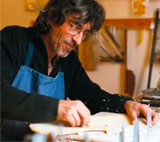 Trained in science and music, François Denis set up his own business as an instrument maker in Angers, a town of the Loire Valley in France. Since 1988 he has devoted himself to violinmaking while continuing parallel in-depth studies on the history of this profession.
Trained in science and music, François Denis set up his own business as an instrument maker in Angers, a town of the Loire Valley in France. Since 1988 he has devoted himself to violinmaking while continuing parallel in-depth studies on the history of this profession.
In 2000, he won the Musicora prize for his work. In 2006, he published the book TRAITE DE LUTHERIE, which shed new light on the origin of Stradivari‘s violin forms, and convincingly recreates the geometric design techniques of the classical period makers, based on proportion and ancient ratios. François Denis has given many lectures and courses in Europe and the U.S., focused on using this geometric design technique for new instruments.
 François Denis
François Denis
19 rue du port de l'ancre
49100 Angers France
www.traitedelutherie.com
www.francoisdenis.com
John Waddle
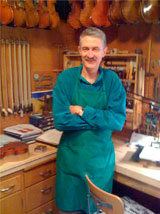 John R. Waddle owns and operates John R. Waddle Violins, Inc. in St. Paul, Minnesota, a full service violin shop. The shop offers a full range of violins, violas, cellos, bows, and services to a local and national clientele. John is a graduate of The Violin Making School of America, and a former employee of Hans Weisshaar in Los Angeles, California.
John R. Waddle owns and operates John R. Waddle Violins, Inc. in St. Paul, Minnesota, a full service violin shop. The shop offers a full range of violins, violas, cellos, bows, and services to a local and national clientele. John is a graduate of The Violin Making School of America, and a former employee of Hans Weisshaar in Los Angeles, California.
In collaboration with radiologist Steven Sirr he has taken a leading role in the use of Computed Tomography in the study of violins, violas, and cellos. Together they have pioneered the use of CT in examining the condition of violins, as well as in studying the air volume and density characteristics of classic violins.
www.maestronet.com/waddle
Steven Alexander Sirr Radiologist
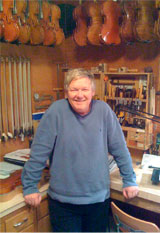 Dr. Steven Alexander Sirr is a radiologist with Consulting Radiologists in Minneapolis, Minnesota. His specialties include Radiology, Body imaging, Diagnostic Radiology, and Nuclear Radiology. Steve is a graduate of The University of Minnesota Medical School in Minneapolis, Minnesota.
Dr. Steven Alexander Sirr is a radiologist with Consulting Radiologists in Minneapolis, Minnesota. His specialties include Radiology, Body imaging, Diagnostic Radiology, and Nuclear Radiology. Steve is a graduate of The University of Minnesota Medical School in Minneapolis, Minnesota.
With violinmaker John Waddle, he has been researching violins, violas, and cellos using Computed Tomography,(CT) since 1989 and has CT scanned several hundred instruments made by most of the important luthiers of the past.
John Topham Dendrochronology
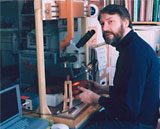 John Topham trained as a violin maker in the Fachschule für Geigenbau, Mittenwald and graduated in 1971. He worked with Dietrich Kessler at the shop of Edward Withers Ltd in London and made and restored many instruments of the violin and viol families. In 1979 he became self-employed and moved to Surrey outside London. In 1985 he graduated with a Bachelor of Arts degree in mathematics and science at the Open University in the UK.
John Topham trained as a violin maker in the Fachschule für Geigenbau, Mittenwald and graduated in 1971. He worked with Dietrich Kessler at the shop of Edward Withers Ltd in London and made and restored many instruments of the violin and viol families. In 1979 he became self-employed and moved to Surrey outside London. In 1985 he graduated with a Bachelor of Arts degree in mathematics and science at the Open University in the UK.
In 1995 he began work on dendrochronological methods to investigate instruments of the violin and viol families, as well as lutes, guitars, and clavichords. He and Derek McCormick have had two papers published in the Journal of Archaeological Science about work done on British and Italian instruments, the latter including the 1716 Antonio Stradivari violin known as the "Messiah". In 2007 he analyzed 20 Brescian instruments at an exhibition held in Brescia, and was asked by the American Federation of Violin and Bow Makers to examine 40 instruments attributed to be from Venice from 1680 to 1790 featured in an exhibition held in Boston.
He has also done dendrochronological examinations for the auctioneers Sotheby’s and Bonhams in London, Christie’s in New York and Skinners in Boston; for institutions such as the Musée de la Musique in Paris and the Ashmolean Museum in Oxford; and companies such as J. & A. Beare Ltd in London, Bein & Fushi in Chicago and Schmitt in Lyon as well as many other dealers and musicians from the UK and other European countries. He is in contact with members of the dendrochronological laboratories at Sheffield University and Queen’s University, Belfast, who have advised him in the acquisition and assessment of data from violins, He has now compiled a database comprising over 2,000 instruments, which has yielded nearly 4,000 sequences of data.
Yuri Namkung http://www.moettrio.com
Violinist Yuri Namkung was born in Seattle, Washington. Her concert debut came at the age of nine with the Northwest Chamber Orchestra. She was invited by conductor Gerard Schwarz in 1995 to perform with the Seattle Symphony and was immediately re-engaged for a second performance in 1996. Since then, she has been performing throughout the United States as soloist and recitalist and in September of 2002, made her European debut with the Zürich-Tonhalle Orchestra in Switzerland under the direction and invitation of David Zinman. In May of 2004 violinist Cho-Liang Lin asked her to join him in a performance of the Bach Double Concerto with the Seattle Symphony and again with the Orchestra of St.Luke’s at Alice Tully Hall under conductor Li Jian in May of 2005. This concert was presented by the Musicians Emergency Fund, of which Miss Namkung was awarded the MEF Junior Award. In September of 2007, she appeared in concert as an MEF award recipient with Li Jian and Kyoko Takezawaat Carnegie Hall’s Zankel Hall. 2008 marked visits to Hong Kong as a member of the Matrix Music Collaborators in New York, and to Venezuela, as a representative of the New England Conservatory, where she performed with members of the Simon Bolivar Symphony Orchestra. In April 2009, she returned to Venezuela to perform the Brahms Concerto with the Simon Bolivar.. An active chamber musician, her festival appearances include La Jolla Chamber Music Society’s SummerFest(CA), Music@Menlo (CA), Ravinia Festival-Steans Institute (IL), Verbier (Switzerland), Mozarteum Academy (Salzburg), Music Mountain (VT), Perlman Music Program NY), Ottawa Chamber Music Festival, and the Virginia Arts Festival.
Miss Namkung is a member of the Moët Trio, which is in the New England Conservatory of Music’s prestigious Professional Piano Trio Program in Boston. Recent and upcoming performances include the trio’s official New York debut through the Schneider Concert Series, Flushing Town Hall through Carnegie Hall’s Neighborhood Concert Series, Kennedy Center in Washington D.C., Boston’s Jordan Hall, Gardner Museum, and extensive outreach through Astral Artistic Services in Philadelphia. The San Francisco Classical Voice had this to say of them: "Separately and together, these are musicians you will want to hear repeatedly in coming years." Deeply passionate about sharing music, she was invited to teach and coach at Music@Menlo by David Finckel and Wu Han, directors of Chamber Music Society of Lincoln Center and Music@Menlo. She has begun a regular relationship with El Sistema in Venezuela, where she will travel annually to teach and perform, and was invited to teach in Panama in January 2009. She received her B.A. at Columbia University in May of 2005. A participant in Columbia's joint program with the Juilliard School, she completed her graduate studies at Juilliard with Cho-Liang Lin and Donald Weilerstein in 2006. She currently studies with Donald Weilerstein and Miriam Fried in the Graduate Diploma Program at the New England Conservatory.
Joseph Curtin
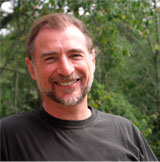 Joseph Curtin is a violinmaker, researcher, and 2005 MacArthur Fellow. Born in 1953 in Toronto, Canada, he began violin lessons at age 12, then went on to study violin at the University of Western Ontario, Literature and Philosophy at the University of Toronto, and viola performance with Rivka Golani.
Joseph Curtin is a violinmaker, researcher, and 2005 MacArthur Fellow. Born in 1953 in Toronto, Canada, he began violin lessons at age 12, then went on to study violin at the University of Western Ontario, Literature and Philosophy at the University of Toronto, and viola performance with Rivka Golani.
In 1977, having concluded he would be neither happy nor successful as a professional musician, Curtin took up violinmaking under the guidance of the Hungarian maker Otto Erdesz. He finished his first instrument a year later, and subsequently worked as a maker in Toronto, Paris, and Cremona. In 1985 Curtin moved to Ann Arbor, Michigan, where he and Gregg T. Alf established the firm of Curtin & Alf. In 1997, Curtin opened his own studios.
Since the early 1990s, Curtin has pursued a strong interest in both violin acoustics and innovation. He has worked with many eminent scientists and researchers, including Charles Besnainou, Xavier Boutillon, Evan Davis, Colin Gough, Carleen Hutchins, Fan Tao, Thomas Rossing, Gabriel Weinreich, and Jim Woodhouse. Along with Fan Tao, Curtin is founder and co-director of the VSA Oberlin Acoustics Workshop, which brings violinmakers and researchers together annually for a week of talks and hands-on experimentation. Curtin is a frequent contributor to THE STRAD and STRINGS magazines. His papers on violin acoustics can be found in the VSA JOURNAL, VSA PAPERS, the CAS JOURNAL, and the PROCEEDINGS OF ISMA 98.
Curtin currently works in a studio by his home on the Huron River, just outside Ann Arbor. He lives with his wife, singer/songwriter/performance-artist Jesse Richards, and their two dogs.
www.josephcurtinstudios.com
Martin Schleske
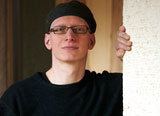
- Born in Stuttgart in 1965
- Violin studies from the age of seven (teachers including Hungarian violist and conductor Attila Balogh)
- Studies at the German violinmaking institute in Mittenwald from 1982 to 1986
- Research workshop in violinmaking at the Schalltechnisches Beratungsbüro Müller-BBM (Planegg, Germany) under Prof. Dipl.-Physiker Helmut A. Müller from 1988 to 1994
- Studies in physics at the Munich Technical University from 1990 to 1994. Thesis: "Eigenmodes of vibration in the creation of a violin"
- Master examination in Hamburg, Germany in 1996
- Own master studio and acoustics laboratory in the Munich area since 1996
- Certain instruments by Martin Schleske are played by internationally known soloists and concertmasters of renowned orchestras
- Martin Schleske is a regular speaker at guest courses in applied violin acoustics and has been an invited speaker at a number of international symposia on musical acoustics (including Vienna, Stockholm, Paris, Lucerne, Seattle, Cleveland and Baltimore)
- Numerous publications and book articles
- Innovation support from the Bavarian Government and the European Commission. Research project involving Thomastik-Infeld, Vienna (i.a.)
- Contributing editor to the journal of the Catgut Acoustical Society, New Jersey
- Certain research results by Martin Schleske have been gathered as part of the exhibition collection of the Deutsches Museum in Munich, Germany
- Martin Schleske has been a member of the artists group "Das Rad" since 2005 (English: "The Wheel"). "Das Rad" brings together artists from all disciplines, including painters, sculptors, designers, musicians, actors, directors, writers, journalists and architects.
- Martin Schleske has been married to Claudia Schleske since 1990. They have two sons Jonas and Lorenz. He is involved in adult education through the church and is a independent member of the editorial board of the publication "Aufatmen" (English: "Breath").
violins@schleske.de
www.schleske.de
Eugene Schenkman
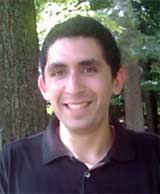 Eugene Schenkman has been in film and video production for the last seven years, since graduating from the Film and Television department at New York University Tisch School of the Arts. He has been playing the violin since the age of six. This, his latest film work, is part of a documentary probe into the world of violinmaking as refined art and important scientific endeavor. He strives to show the spiritual energy invested in crafting fine instruments and the intense commitment to acoustic research practiced by the new and heretofore largely unknown pioneers of the craft.
Eugene Schenkman has been in film and video production for the last seven years, since graduating from the Film and Television department at New York University Tisch School of the Arts. He has been playing the violin since the age of six. This, his latest film work, is part of a documentary probe into the world of violinmaking as refined art and important scientific endeavor. He strives to show the spiritual energy invested in crafting fine instruments and the intense commitment to acoustic research practiced by the new and heretofore largely unknown pioneers of the craft.
Eugene hopes that this work will shed greater light on the continuing drive by the featured violinmakers to share innovation with and inspire a new generation of acoustic instrument designers to reach beyond the enormous shadow cast by the great Cremonese masters of the past.
Video clips used for the Strad3D.org project are primarily chapters and vignettes derived from a larger piece that Eugene is preparing for major festival screenings and subsequent television distribution.
Da-Hong Seetoo
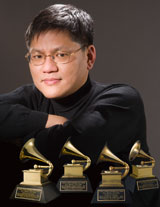 Curtis- and Juilliard-trained violinist Da-Hong Seetoo ranks among today's most in-demand classical recording producers and engineers. Winner of five Grammy Awards, he combines the latest software technologies with his own custom-designed electronics, achieving unparalleled musical and sonic results. His deep musical knowledge and pursuit of perfection have earned him the trust of some of the world’s most prestigious and prolific recording artists, who have often likened him to a valued member of their ensembles: "He makes music with us.” Da-Hong Seetoo has produced records for the classical music industry’s most important recording labels.
Curtis- and Juilliard-trained violinist Da-Hong Seetoo ranks among today's most in-demand classical recording producers and engineers. Winner of five Grammy Awards, he combines the latest software technologies with his own custom-designed electronics, achieving unparalleled musical and sonic results. His deep musical knowledge and pursuit of perfection have earned him the trust of some of the world’s most prestigious and prolific recording artists, who have often likened him to a valued member of their ensembles: "He makes music with us.” Da-Hong Seetoo has produced records for the classical music industry’s most important recording labels.
Jeff Loen
Dr. Jeff Loen is one of the most highly educated professionals working in the violin trade. In addition to formal education as a research scientist, he is professionally trained in instrument setup and repair, bow rehair, advanced bow repairs, violin making, artistic varnishing, acoustical adjustments, and finish retouching. In addition to training from numerous experts, he has intensively studied classic old instruments in the world’s best museums.
He has been making and repairing instruments since 1994. He writes articles and books on classic instruments and acoustics. He is internationally known as Editor-in-Chief of the Catgut Acoustical Society Journal (2000-2004), and author of a popular book on classic instrument thickness graduation maps. Jeff has accepted invitations to speak before the American Federation of Violin and Bow Makers, the Violin Society of America, and Oberlin Violin Workshops (violin setup & violin acoustics). An avid string player, he has played violin in civic symphonies, folk dance bands, Celtic duos, and theatrical performances, and fiddle/mandolin/banjo/guitar in bluegrass bands,
George Stoppani
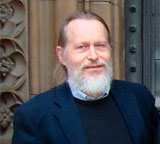 George Stoppani inherited his Italian name from his Venetian grandfather, Pietro Faustino, who came to London in the early 1900s. George's father and mother were, respectively, a painter and a sculptress. George studied English and Related Literature at York University, graduating in 1972, but a few years on turned to instrument making. Circa 1977 he began an association with Northern Renaissance Instruments in Manchester where he developed an interest in historical matters and string making. He made a large number of period instruments but then began to make modern orchestral instruments as well.
George Stoppani inherited his Italian name from his Venetian grandfather, Pietro Faustino, who came to London in the early 1900s. George's father and mother were, respectively, a painter and a sculptress. George studied English and Related Literature at York University, graduating in 1972, but a few years on turned to instrument making. Circa 1977 he began an association with Northern Renaissance Instruments in Manchester where he developed an interest in historical matters and string making. He made a large number of period instruments but then began to make modern orchestral instruments as well.
Another more recent interest is modal analysis. This means taking measurements from assembled and strung-up instruments to see what actually happens when they vibrate. This has enormous potential for making instruments with superior playing qualities and for diagnosing problems on older instruments.
George has given talks at the Tiverton Conference (the fore-runner of the Dartington Conference) and has written articles for THE STRAD magazine, EARLY MUSIC TODAY, the BVMA newsletter and the CAS JOURNAL. He is on faculty at the Oberlin Acoustics Workshop, and has given many workshops and lectures on modal anaysis for violinmakers.
Tucker Densley
 Maker, Dealer, Photographer of Fine Violin Family Instruments
Maker, Dealer, Photographer of Fine Violin Family Instruments
tuckerdensley@mac.com
Tucker Densley received violinmaking training at the American School of Violinmaking in Salt Lake City, and additional restoration and expertise experience as a current staff member at Ruening and Sons Violins Inc.
He has become a pre-eminent practitioner of high-resolution digital photography of fine violins and musicians. His work has been published in numerous books, and in THE STRAD magazine, most recently on the full size poster of the Titian Stradivari of 1715.

Member: American Federation of Violin and Bow Makers,
Member: Violin Society of America
Aaron Boyd
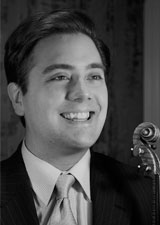 Violinist Aaron Boyd enjoys a versatile career as an established chamber musician, soloist and teacher. Since making his debut with the Pittsburgh Symphony at the age of 17, Mr. Boyd has been heard in concert halls across the United States, Europe and Asia. As a chamber musician, he has collaborated with members of the Beaux Arts Trio; the Juilliard, Guarneri and Orion Quartets; and Phillippe Entremont, Mitsuko Uchida, Anner Bylsma and Gerard Poulet. Mr. Boyd has played as a member of the Metamorphosen, Prometheus and Orpheus chamber orchestras and toured internationally as a member of the Sejong Soloists. He has participated in the Marlboro, Tanglewood, Fontainbleau, IMS Prussia Cove, Great Mountains (Korea) and La Jolla festivals and has been a prizewinner in numerous competitions including the Klein Violin Competition, the Tuesday Music Society and the Pittsburgh Concert Society.
Violinist Aaron Boyd enjoys a versatile career as an established chamber musician, soloist and teacher. Since making his debut with the Pittsburgh Symphony at the age of 17, Mr. Boyd has been heard in concert halls across the United States, Europe and Asia. As a chamber musician, he has collaborated with members of the Beaux Arts Trio; the Juilliard, Guarneri and Orion Quartets; and Phillippe Entremont, Mitsuko Uchida, Anner Bylsma and Gerard Poulet. Mr. Boyd has played as a member of the Metamorphosen, Prometheus and Orpheus chamber orchestras and toured internationally as a member of the Sejong Soloists. He has participated in the Marlboro, Tanglewood, Fontainbleau, IMS Prussia Cove, Great Mountains (Korea) and La Jolla festivals and has been a prizewinner in numerous competitions including the Klein Violin Competition, the Tuesday Music Society and the Pittsburgh Concert Society.
Mr. Boyd’s passionate interest in contemporary music has led to numerous premiers in concert and on record, including Milton Babbitt’s 6th String Quartet and Clarinet Quintet. Mr. Boyd is currently violinist and founding member of the Zukofsky Quartet, Quartet-In-Residence at New York’s Bargemusic series.
With interests ranging beyond the classical genre, Mr. Boyd has played and recorded in collaboration with jazz legend Dick Hyman and chanteuse Badomi DeCesare, and appeared in concert on the mandolin with flutist Paula Robison. Highlights of the upcoming season include an appearance on Lincoln Center’s "Great Performers" series with Midori and the premier of David Gommper’s Violin Concerto with the Manhattan Sinfonietta. Also, at the invitation of Columbia University and The University of Chicago, the Zukofsky Quartet will present all of Milton Babbitt’s String Quartets in one concert.
Born in Pittsburgh, Mr. Boyd began playing the violin at age 7 and graduated from The Juilliard School where he studied with Sally Thomas and coached extensively with Harvey Shapiro. As a recording artist, Mr. Boyd can be heard on the Tzadik, Furious Artisans, North/South and Naxos labels.
Mr. Boyd recently joined the Violin Faculty of Columbia University and plays a violin crafted in 2002 by Samuel Zygmuntowicz.
Christopher Reuning
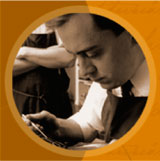 Christopher Reuning, a violin maker, restorer and expert, grew up in a musical family and he began playing cello at the age of seven. He began as a violin making apprentice at the age of twelve at the House of Primavera in Philadelphia, Pennsylvania. For the next six years, to supplement his Philadelphia training, he frequently traveled to Cremona, Italy to work with Virgilio Capellini. During those years he began to develop a close association with the important experts in violin identification Dario D'Attili and, later, Charles Beare.
Christopher Reuning, a violin maker, restorer and expert, grew up in a musical family and he began playing cello at the age of seven. He began as a violin making apprentice at the age of twelve at the House of Primavera in Philadelphia, Pennsylvania. For the next six years, to supplement his Philadelphia training, he frequently traveled to Cremona, Italy to work with Virgilio Capellini. During those years he began to develop a close association with the important experts in violin identification Dario D'Attili and, later, Charles Beare.
Christopher has been director of Reuning & Son Violins since 1978 and purchased the business from his parents in 1984. In 1994, he moved the business to its current location in Boston, Massachusetts.
Christopher takes special interest in researching the history of the old master violin makers and the identification of old violins. He also tries to find enough time at the workbench to have a restoration project in progress as well as occasionally making a violin.
Christopher is Vice-President of the American Federation of Violin and Bow Makers, an advisor to The North Bennett Street School Violin Making Department, on the board of The Boston Chamber Music Society, and also co-founded Tarisio Auctions in 1999, which now leads the industry in market share.
He also still finds time to enjoying performing and is a member of the Longwood Symphony Orchestra. He is the father of two daughters, Gretchen and Monica, of whom, in spite of their being wind players, he is exceedingly proud.
creuning@reuning.com
www.reuning.com
Alvin Thomas King Preliminary disc editor
Alvin Thomas King is active in making, repairing, and adjusting fine violins. He has both a strong training in classical, traditional violinmaking and appreciation for important research in violin acoustics and design
He studied with Geigenbaumeister Karl Roy at the Program for Violin Craftsmanship at the University of New Hampshire for many years, ultimately serving as his Assistant, and worked with him to prepare his monumental book, "The Violin: Its History and Making," for publication in 2006. For additional information about the book, please visit www.KarlRoyViolinBook.com.
He also studied with Dr. Carleen Hutchins, renowned for her path-breaking research into violin acoustics. He became an active member of the Catgut Acoustical Society, serving variously as Trustee, Society President, and Editor of the CAS Journal.
He has collaborated with Dr. Jeffrey Loen on thickness mapping of classical instruments, and published an article with Terry Borman incorporating research on density and CT scans.
He has also researched and written extensively on classical f-hole positioning techniques and is preparing a book length exploration of these design principles.
www.fiddleheadstrings.com
Fan-Tao Chia
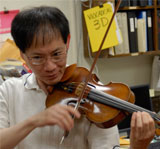 Fan Tao, co-director of the Oberlin Violin Acoustics Workshop, is Director of Research and Development at D’Addario & Company, where he works on bowed and guitar strings. His interest in violin acoustics was fostered by his mentor Norman Pickering. An accomplished violinist and violist, Tao is an avid chamber music player. He holds electrical engineering degrees from Caltech and Princeton University. He is a Trustee of the CAS Forum (formerly Catgut Acoustical Society) and Vice-President of the Violin Society of America.
Fan Tao, co-director of the Oberlin Violin Acoustics Workshop, is Director of Research and Development at D’Addario & Company, where he works on bowed and guitar strings. His interest in violin acoustics was fostered by his mentor Norman Pickering. An accomplished violinist and violist, Tao is an avid chamber music player. He holds electrical engineering degrees from Caltech and Princeton University. He is a Trustee of the CAS Forum (formerly Catgut Acoustical Society) and Vice-President of the Violin Society of America.
Fan.Tao@Daddario.com
www.daddariobowed.com
The Testing Team ECU, September 11-13, 2005
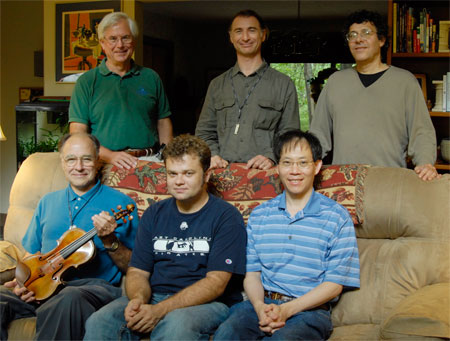
Bottom row, from left: George Bissinger, Daniel Rowe, Fan Tao Chia
Top row: Joseph Rehg, Joeseph Curtin, Sam Zygmuntowicz
Polytec Inc www.polytec.com
David Oliver VP Business Development
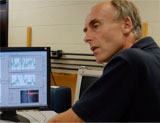 For over 30 years Polytec has been the leader in high-technology, laser-based measurement solutions to researchers and engineers.
For over 30 years Polytec has been the leader in high-technology, laser-based measurement solutions to researchers and engineers.
They have provided the most precise and reliable optical instruments and sensors available for non-contact measurement, setting Polytec apart as the gold standard in the design and manufacture of vibrometer and velocimeter systems.
The high degree of innovation of Polytec Laser Measurement Systems has been acknowledged by numerous national and international awards, such as the Photonics Circle of Excellence 2001 award for the MSV-300 Micro-Scanning Vibrometer, and the AMA 2005 Sensor Innovation Award for the MSA-400 Micro System Analyzer.
Vikrant Palan Testing sessions chief technician
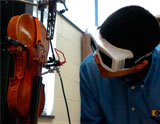
Harry Bolick Art Director and Digital designer
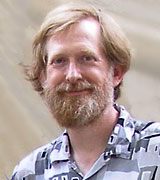 Harry's design career has so far encompassed painting, photography, illustration, print and web design for major record labels, corporations, and multimedia design firms. He is also a ferocious southern-style fiddler with five recordings to his credit.
Harry's design career has so far encompassed painting, photography, illustration, print and web design for major record labels, corporations, and multimedia design firms. He is also a ferocious southern-style fiddler with five recordings to his credit.
www.bolick.net
Additional Contributors:
Adrián López, Programmer (software/content update for modern browsers)
Joey Carey Disc 2 production joeycarey@gmail.com
Dr. Claudio Sibata, Radiologist, Leo Jenkins Cancer Center, E. Carolina University
Ara Gregorian, Subjective Evaluations, Violinist, ECU Professor
Daniel Rowe, Testing Team Graduate Assistant
Carla Shapreau, Legal
Heritage Insurance, Ellis Hershman, Insurance
Colin Gough, -School of Physics and Astronomy, University of Birmingham
Jim Woodhouse, Department of Engineering, University of Cambridge
Gabriel Weinreich, Professor Emeritus at the University of Michigan
We gratefully acknowledge the support of the following;
East Carolina University
The National Science Foundation
Violin Society of America
VSA CAS Forum
VSA Oberlin Acoustics Workshop
Polytec Inc.
